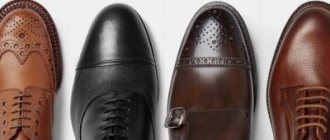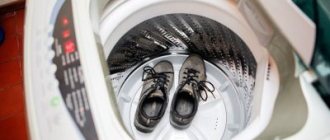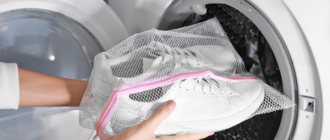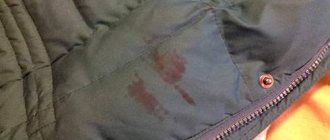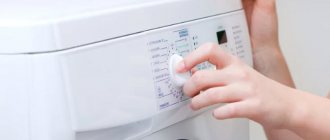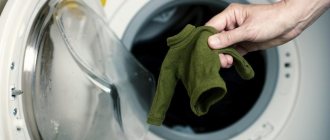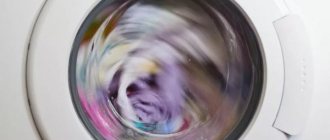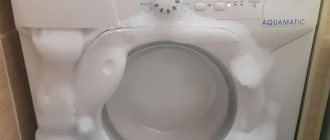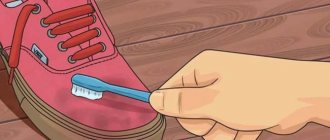Can sneakers be washed in a washing machine?
Can. If you don’t wash your sneakers, they will lose their appearance: you need to regularly clean your shoes from dirt inside and out - this will help renew the color, get rid of the unpleasant odor and increase their service life.
Before washing, pay attention to the washing instructions on the label: if there is a crossed out square with a circle on the label, then automatic washing is prohibited.
Typically, machine washing suits sneakers:
- from textiles: canvas, tarpaulin, viscose and other materials;
- from synthetic materials: nylon, elastane, polyester;
- from membrane and mesh materials;
- made of eco-leather and leatherette.
But there are materials that do not tolerate automatic washing: leather, suede, nubuck and velor. It is necessary to carefully wash combined models consisting of several types of materials: for example, fabric, leather and rubber. Do not wash sneakers with small decorations: rhinestones, stones, fur, metal parts and stripes. If the part comes off and falls into the drain, a clog will appear.
How to make them snow-white
If after washing the sneakers turned yellow, or they were old and simply lost their appearance, we will tell you how you can return the product to its original snow-white color. This can be done both with the help of household chemicals and with the help of improvised means available in every home. Let's consider all the options.
Household chemicals
Special store-bought products for bleaching fabric products are not all suitable for lightening shoes. Only oxygen-based products will cope with this task and will not damage the material. Such bleaches and stain removers contain the “Oxi” symbol.
To whiten sneakers using household chemicals, take the product of your choice, add a little water until you get a paste and apply the mixture using the soft side of a kitchen sponge to the fabric around the entire perimeter of the sneaker. Leave the mixture for 10 - 15 minutes, then thoroughly rinse and rinse the shoes under running water.
Soda
At home, white fabric sneakers can be washed with soda. Sodium bicarbonate, also known as baking soda, is found in every home and is used not only as a leavening agent for dough, but also for cleaning household items. When cleaning sneakers, baking soda is used as a cheap and reliable bleach.
Cleaning steps:
- Mix baking soda with water to form a paste.
- Rub the mixture into the fabric using a sponge.
- Leave for a few minutes.
- Rinse off any remaining baking soda under running water.
Note: for better whitening, use baking soda together with other available bleaches, such as vinegar, whitening toothpaste or hydrogen peroxide.
Toothpaste
Toothpaste is most often used to remove stains from white sneakers rather than to wash the entire item. In order to remove the stain, you need to take a whitening toothpaste that does not contain multi-colored crystals.
The paste must be rubbed into the stain, left for 10 minutes, then rinsed and washed the shoes in the usual way using household chemicals.
Radical whitening
If using all of the above methods it was not possible to restore the cleanliness and whiteness of your shoes, you can resort to a radical method of removing yellowness and stains from white fabric. To do this you will need:
- Table vinegar – 2 tbsp;
- Baking soda – 1 tsp;
- Washing powder for white clothes – 2 tbsp;
- Hydrogen peroxide – 1 tbsp.
Mix all ingredients and apply the resulting mixture to the fabric for 10 minutes. After this time, rinse everything under the tap.
Important! You cannot bleach shoes with bleach - it has a very aggressive effect on the fabric, can lead to yellowing, holes and, as a result, damage to your favorite pair of shoes.
Selecting a washing mode
Some washing machines have a special “Sports Shoes” mode. If this is not the case, then it is better to choose a delicate or hand wash mode. The “Wool” program is also suitable.
You can set the settings yourself. To prevent shoes from coming apart and becoming deformed, a temperature of 40 degrees is suitable. It is better to wash membrane sneakers in cold water or at a temperature not exceeding 30 degrees.
The spin cycle can only be used to wash textile sneakers. The optimal number of revolutions is 400–500 per minute: too intense spinning can damage shoes or the drum. Disable the function if you plan to wash shoes with defects or decorative elements.
Removing stains from sneakers
Old or stubborn stains should be treated in advance because machine washing may not be able to remove them.
It is permissible to pre-soak sneakers in non-chlorine washing powder or soap solution. There are several ways to deal with local pollution.
- Clean the stain with toothpaste.
- Mesh sneakers can be cleaned using soda, slaked with lemon juice; the resulting foam must be carefully treated with the fabric.
- A mixture of baking soda, liquid soap, and toothpaste will help remove stains.
Removing paint stains
Paint stains are a special category of complex stains, so they need to be removed as soon as possible; the older the stain, the more difficult it is to get rid of. To remove such stains use:
- solvent applied to cotton wool;
- acetone, also with a cotton swab, if there is no acetone, then you can resort to nail polish remover;
A mixture of one teaspoon of soda and 100 ml of water will help to clean such a stain from leather sneakers without damage.
If such a remedy does not work, then you should resort to dry cleaning or try to paint over the mark with special paint for white shoes.
Advice! Before using any product, test its effect on an inconspicuous area of fabric.
Powder selection
Liquid detergents are suitable: soap solution, gels and laundry capsules. It is better to avoid powder: many formulations contain colored granules that do not dissolve in cold water and can leave streaks on sneakers. Only delicate cleaning products can be used: concentrates with acid and chlorine should not be used.
Colored items should not be washed with softeners and conditioners, as the compositions can damage the shoes or ruin the color.
Do not add shampoos, dishwashing detergents or liquid soap to the machine compartment. They contain a high concentration of surfactants, so they foam strongly and can cause damage to equipment.
Methods for whitening sneakers
Shoes will sparkle white again after using folk and modern methods.
Leather shoes cannot be washed, but they can also turn yellow under the influence of various factors, so it is worth considering methods of bleaching both types of materials.
Leather shoes
- A mixture of washing powder, hydrogen peroxide, vinegar and lemon will remove yellowness from the product.
- Special shoe paint for white shoes will return the desired color.
Fabric shoes
- Ammonia, rubbed in with a cotton swab in several approaches at intervals of 15 minutes, can eliminate yellowness.
- A good home cleaning method is oxygen bleaches, which can either be applied with a soft cloth or used in a solution with laundry detergent to soak. Soaked sneakers should be periodically rubbed on all sides with a brush.
- You can bleach fabric by using tooth powder applied to the fabric with the abrasive side of a slightly damp dishwashing sponge. You need to leave it for a couple of hours, and then wipe off the residue with the soft side of a sponge.
Using the bag
Special bags for washing sneakers in the washing machine have shock-absorbing foam inserts. The mesh will secure the pair so that it is not damaged by friction. If a part comes off, it will not be pulled into the drain. The bag also protects the drum: washing shoes with heavy soles can deform it.
If you don't have a special bag at home, you can use a pillowcase: place rags or terry towels in it to soften the impact from the soles, then insert your shoes and tie the pillowcase in a knot.
Tell the machine - NO!
Glowing sneakers must be handled with care. Sneakers with LED lighting cannot be washed in a washing machine.
A sneaker model that glows requires more painstaking cleaning.
These shoes cannot be machine washed for the following reasons:
- The design is equipped with microcircuits and other parts that power the LEDs. If it comes into direct contact with moisture, the device will fail. I'll have to buy new sneakers.
- The sneakers that glow have a difficult patterned sole. A lot of dirt gets into it, which is sometimes difficult to wash off even with your hands. And the machine will completely break down or its functioning will be disrupted.
- If the sneakers have a charging connector and are recharged from the mains, and not from sunlight, you need to be even more careful with them. Such products may only be washed by hand. The machine will damage the charging connector and some elements.
- If the sneakers have phosphorus coating, washing the machine is also prohibited. Hitting the shoe against the drum may damage the application.
It is recommended to clean these products manually using home remedies or special chemical compounds, which are best purchased in the form of foam.
Features of washing shoes made of different materials
The choice of care products and type of washing depends on the material of the sneakers. Let's consider the main nuances.
Suede and nubuck
Water can cause suede and nubuck shoes to become rough and fade. Therefore, it is not recommended to wash it: it is better to treat it with professional products and a brush.
You can remove fresh dirt with a paper towel, and dried dirt with a damp sponge. Gently scrub the stains, wait until the surface is dry, and clean the sneakers with a suede brush.
If this method does not help, try using a brush with rubber or rubber bristles: it will help get rid of grease. You can first sprinkle the problem area with talcum powder so that it absorbs the dirt. To get rid of complex stains on delicate materials, it is better to contact a dry cleaner: professionals will deal with any stains and restore the appearance of your shoes.
Leather and leatherette
Leather products do not tolerate interaction with water well. These sneakers can be dry cleaned. In case of severe contamination, you can carry out a wet treatment: carefully clean the inside of the shoes with a damp brush, wash the insoles and laces. It is important to dry your shoes well.
Use liquid cleansers to remove stubborn stains from leather. Powders are not suitable: grains are difficult to completely wash out, and they can scratch the surface. Gently scrub stained areas with a soft bristle brush or sponge, then rinse gently.
Before washing leatherette shoes, check the label: some materials can be machine washed. If this is prohibited, then you need to care for your sneakers in the same way as your leather.
Net
Shoes with mesh should not be washed with powder or bleach. Do not add too much detergent, otherwise the shoes will take longer to rinse and may become damaged.
If the mesh is flimsy, it is safer to clean the dirt by hand. Pour dish soap into the water, soak a soft sponge in the solution and gently scrub the stains.
Textile
Fabric shoes tolerate automatic washing well. Place the shoes in the net, put them in the drum and set to delicate mode. The washing duration is about 1 hour, spinning at 400–500 rpm.
If your sneakers are heavily soiled, add a stain remover to the powder compartment. To prevent streaks from appearing on the fabric, install an additional rinse.
Sneakers with membrane
If the manufacturer does not prohibit automatic washing, then sneakers with a membrane should be washed on a delicate cycle using liquid detergents without spinning.
But more often it is recommended to wash the material by hand: clean the shoes with a cloth or soft brush in warm water with detergent.
For cleaning, you cannot use compounds containing wax, oils, or fat, as they impair the vapor permeability of the material. To restore the properties of the membrane, use special impregnations.
Cleaning laces
If the dirt is not significant and the fabric is simply grey, simply rub the laces with laundry soap and then wash them in the machine.
To clean white laces from dirt, just rub them with laundry soap and wash them in a machine.
For more serious contamination, the following scheme is used:
- Add a stain remover intended for white items to a container of warm water.
- Soak the laces in this solution and leave them overnight.
- Wash the laces either by hand with soap or with light-colored items in the machine.
- If necessary, repeat the procedure.
In more difficult cases, you can use a stain remover for white items.
Processing depending on color
When washing sneakers, consider the color of the material and dye fastness. Then the products will not deteriorate and will look like new.
White
To preserve the material and its snow-white color, you can use a gentle oxygen bleach. Can be washed on the “Synthetic” or “Delicate Wash” mode.
If there are stains on the sneakers, you need to treat them with soap and water before washing. If the shoes have colored inserts or metal elements, it is better to wash the shoes by hand, otherwise the fabric may become stained.
Colored
To check whether a product is fading, rub the material with a damp cloth. If it remains clean, then the sneakers can be washed in a machine. If the napkin is heavily stained, it is better to clean the shoes by hand.
It is better to wash colored shoes at a low temperature - this way the color will last longer. Use special capsules and gels for washing colored materials.
Caring for white sneakers
Sneakers can be either fabric or leather. Care measures also depend on the material. The differences lie in the bleaching products used and how to wash white sneakers:
- fabric shoes can be washed using a machine, but leather shoes do not tolerate strong wetness and can crack and become deformed when drying;
- for leather sneakers you need to use special sponges and soft fabrics to avoid scratching the surface;
- textile shoes require hard brushes to clean deeply embedded dirt;
- Small abrasions and scratches on the surface of leather shoes can be easily masked with special creams, whereas this cannot be done with fabric sneakers.
It is important to remove stains and dirt immediately after they appear.
After a few days, it will be much more difficult to get rid of the defects. Proper care of white sneakers is not too difficult. However, it allows you to maintain a neat appearance and extend its service life.
How to dry properly
It is better to dry your shoes in the fresh air, avoiding direct sunlight. Do not place sneakers on a radiator: this method will damage the sole.
If you need to quickly dry your shoes, you can use a fan: unlace the sneakers, take out the insoles and direct a stream of air at the pair. Drying will take about an hour. If there is no fan, you can use a hairdryer with a cold setting.
Another way to keep shoes dry is by crumpling up newspaper. To do this, stuff each sneaker with paper and leave it for 4-6 hours. When the newspaper gets wet, replace it with dry one. But there are nuances: do not use newspaper if you have white products - printing ink can leave marks.
For quick drying, use regular baking soda or salt. It is enough to heat one of the products in a frying pan, pour it into two socks and place them inside the sneakers.
How to scrub white sneaker soles
The listed methods tell you how to remove dirt from the upper part of fabric or mesh sneakers. However, the white rubber or plastic soles of shoes are also susceptible to contamination, and it can be difficult to remove dirt from them.
You can wipe off the soles of white sneakers using the following methods.
- Soapy solution. A bar of laundry soap is grated and then diluted in warm water to obtain a concentrated solution. The soles of the sneakers, previously washed under the tap, are immersed in water and left for an hour. After this time, the soles are treated with a stiff brush, and then the soap is thoroughly washed off under the tap.
- Table vinegar. Water and vinegar are mixed in a ratio of 3 to 1, the soles of the shoes are washed under the tap, and then thoroughly treated with a sponge soaked in a vinegar solution and washed off with water.
- Nail polish remover. Acetone-based products can easily remove various stains from white soles; you need to soak a cotton pad in the solution and then rub the problem areas. However, you cannot use this method all the time - aggressive agents harm many sole materials.
A regular eraser works well to remove black streaks and some other stains. If the dirt is not absorbed deeply into the structure of the sole, a rubber band will easily remove it.
We recommend reading: How to remove brilliant green from linoleum
Problems after washing and their solutions
The main consequences of improper washing:
- Yellowing. Shoes lose color due to washing with high temperatures, intense spinning and tumble drying. To save yellowed items, wash them at 40 degrees with mild bleach.
- Divorces. These are traces of detergent. They can be easily eliminated: rinse your shoes thoroughly.
- Loss of shape. Consequences of washing at high temperatures: shoes become deformed, wrinkled or cracked. To return your sneakers to shape, dampen them slightly, stuff them with newsprint, and let them dry.
- Creak. The appearance of squeaking may be due to slight deformation of the sole after improper washing. Find a crack or depression in the sole and pour colorless silicone into it - this will help eliminate the sound.
It is important to properly wash capricious materials: leather, nubuck and suede. If you choose the wrong method, the material will become rough, the color may fade, and traces of glue will appear on the sole. The fabric can shrink in width and length, so it is important to choose the right temperature conditions.
Cleaning odor inside
Hydrogen peroxide and an unsaturated solution of potassium permanganate and other home methods help get rid of the unpleasant odor inside luminous sneakers.
- The peroxide is simply poured into the boot. When the medicine stops bubbling, the liquid is drained, and the sneakers are stuffed with paper and sent to dry.
- You can freshen the inside of your sneakers using ammonia. Soak a cotton pad in the product and treat the internal surfaces of the product. Wipe with a dry cloth and take out into fresh air.
- Ammonia smells unpleasant; use a respirator or medical mask during the procedure.
- If you are afraid that excess liquid will ruin your sneakers and there will be no trace left of the glow, try the dry method of odor removal.
- Lightly spray the insides of the sneakers with water. Then immediately sprinkle in the baking soda. Don't be afraid, it won't do any harm. Leave the sneakers overnight, shake out the baking soda in the morning and vacuum the items.
- Buy chamomile in bags at the pharmacy. Place 1 sachet in each shoe and leave them inside overnight. Chamomile improves the microenvironment of sneakers, thereby preventing the proliferation of harmful microorganisms. Therefore, odors are eliminated. Chamomile can be used daily.
The most important
You can remove stubborn stains on shoes by hand or in the washing machine. Both methods are considered absolutely safe if you follow all the rules described in the article.
- Before washing, read the manufacturer's recommendations written on the label.
- Prepare your shoes: take out the laces, liners and insoles, check that there are no small stones, earth, or sand inside.
- Use a mesh bag - this will protect your shoes and washing machine from deformation.
- If the sole is glued and not stitched, it is better to choose hand washing. Pre-soaking is strictly prohibited.
Cleaning Skechers without washing
Of course, no matter how delicate the washing program is, manual shoe cleaning will in any case be more gentle. Therefore, if possible, it is better to follow the manufacturer's recommendations and wash your sneakers by hand. The algorithm of actions is as follows:
- take out the laces, take out the insoles. These items will have to be washed separately;
- wipe the boots with a damp cloth to remove any dust that has settled on the material;
- Wash the sole from dirt, use a brush to clean out any debris stuck in the tread;
- take light-colored napkins and place them inside the shoes, spreading them over the soles. This will protect the product from liquid getting under the insole;
- fill a basin with warm water, temperature 30-40°C, pour in detergent, mix well;
- dip the brush into the soapy solution and wipe the surface of the sneakers, paying special attention to heavily soiled areas;
- rinse your sneakers under running warm water;
- take out the napkins included in the sneakers and dry the sports pair.
It is better not to use dry powders; they do not completely dissolve in water and stains may remain on the shoes. It is advisable to use special liquid cleaning products; they are the safest, although regular dish gel or shavings of laundry soap will also work. A melamine sponge will help remove stubborn stains. You can buy a “washcloth” at a hardware store for 30-50 rubles. It is enough to cut a piece from it, moisten it, and “walk” it over the contaminated area.
Source

